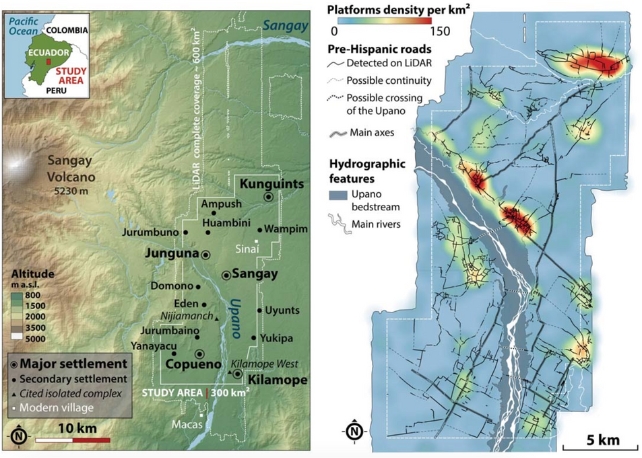
When intact, the Amazonian forest is dense and difficult to penetrate, both on foot and with scanning technologies. Over the past several years, however, improved light detection and ranging scans have begun to penetrate the forest canopy, revealing previously unknown evidence of past Amazonian cultures.
Consequently, archeologists are now uncovering clusters of lost cities in the Amazon rainforest that were home to at least 10,000 farmers around 2,000 years ago.
A dense system of pre-Hispanic urban centers is being found in the Upano Valley of Amazonian Ecuador. It is a series of earthen mounds and buried roads in Ecuador was first noticed more than two decades ago by archaeologist Stéphen Rostain. But at the time, “I wasn’t sure how it all fit together,” said Rostain, one of the researchers who reported on the finding Thursday in the journal Science.
Recent mapping by laser-sensor technology revealed those sites to be part of a dense network of settlements and connecting roadways, tucked into the forested foothills of the Andes, that lasted about 1,000 years.
The settlements were occupied by the Upano people between around 500 B.C. and 300 to 600 A.D. – a period roughly contemporaneous with the Roman Empire in Europe, the researchers found.
Residential and ceremonial buildings erected on more than 6,000 earthen mounds were surrounded by agricultural fields with drainage canals. The largest roads were 33 feet wide and stretched for 6 to 12 miles.
While it’s difficult to estimate populations, the site was home to at least 10,000 inhabitants – and perhaps as many as 15,000 or 30,000 at its peak, said archaeologist Antoine Dorison, a study co-author at the same French institute. That’s comparable to the estimated population of Roman-era London, then Britain’s largest city.

The discovery changes what we know about the history of people living in the Amazon. The houses and plazas in the Upano area in eastern Ecuador were connected by an astounding network of roads and canals. The Amazon is often thought of as a “pristine wilderness” with only small groups of people. But recent discoveries have shown us how much more complex the past really is,” he said.
The LIDAR data did not stop at uncovering ancient settlements; it revealed that the open spaces between settlements were drained fields for cultivating crops like maize, beans, sweet potatoes, and cassava – a woody shrub with starchy root tubers.
The organization of the cities reveals the sophistication and engineering capabilities of these ancient cultures, according to the researchers, who concluded that the ‘garden urbanism’ of the Upano Valley provides further proof that the Amazon is not the pristine forest once depicted. The new studies reveal settlements that evidence an intricate rainforest society that predated the European contact in the Americas.
And what if the extensive research studies lead to other discoveries to shed the light on the mysteries of ancient forgotten civilizations and myths of sunken civilizations?
References
- Archeologists uncover “lost valley” of ancient cities in the Amazon rainforest – link
- How the “lost cities” of the Amazon were finally found – link
- A huge ancient city has been found in the Amazon, hidden for thousands of years by lush vegetation. link
- Cluster of Ancient Lost Cities in The Amazon Is The Largest Ever Found – link
- Two thousand years of garden urbanism in the Upper Amazon – link





